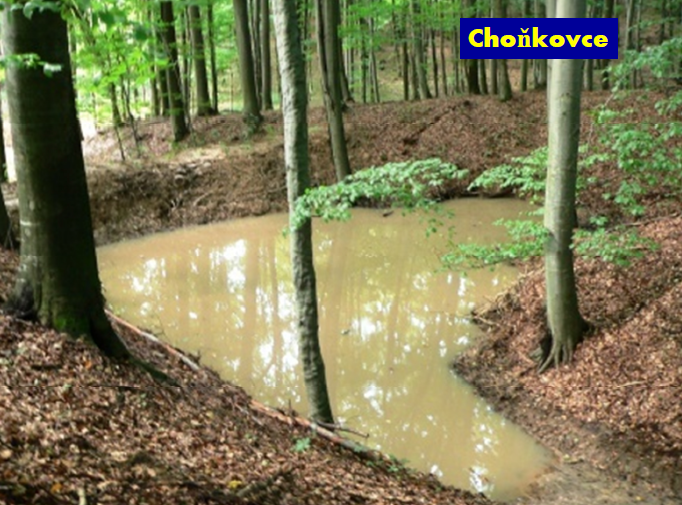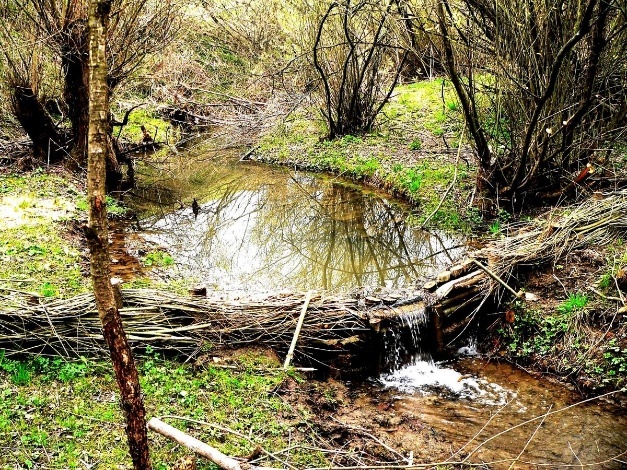- Leaky dams
- Woody dams
- Leaky barriers
- Log dams
- Natural dams
- Tree dams
- Log jams
Peak flow control structures are interventions designed to manage and reduce the velocity of surface water flow in forested and upland catchments. These 'sponge measures' aim to reduce flow velocity, temporarily store runoff and promote infiltration. This mitigates flood peaks, controls sediment transport and improves water quality. They comprise a variety of engineered and nature-based solutions that work together to regulate hydrological dynamics.
Typically implemented in networks of forest ditches or upland catchments, these structures include peak flow control ponds and basins that limit the rate at which water flows out of drainage systems. By slowing water movement, they contribute to sediment control and reduce the magnitude of flood peaks. Although these basins may gradually fill with sediment, their functionality can be preserved through periodic sediment removal.

Peak flow control basin in forest, (Slovakia)
Source: Michal Kravcík’s presentation, NWRM Workshop 1
Overland flow areas are another form of peak flow control commonly used in peatland forestry. These areas are designed to intercept and treat runoff from forestry activities such as ditch maintenance, road construction and harvesting. They are created by installing semi-permeable dams in forest ditches and constructing lateral ditches upstream. Woody diverters and woody deflector can also help slow and disconnect the drainage network, channeling water into preferential storage areas.
This allows water to overflow and spread across the land during high flows. It promotes sediment deposition and reduces the transport of particulate and dissolved organic carbon. Overland flow areas are particularly important in mitigating the effects of drainage in peatlands, as this can lead to an increased export of nutrients and organic matter. While existing wetlands can be adapted for this purpose, ecologically sensitive mires should be avoided to prevent adverse impacts on vegetation.

Ditch for overland flow (SK)
Source: Michal Kravcík’s presentation, NWRM Workshop
Leaky dams are a widely used green engineering option for peak flow control which mimics the natural accumulation of large pieces of wood in rivers. Made from logs or woody debris, they are usually positioned perpendicular to the flow of the river, spanning the channel and extending onto the floodplain. Unlike traditional large wood installations used in river restoration, leaky dams are semi-permeable, allowing low flows to pass while holding back high flows. This creates temporary water storage, enhances infiltration and reduces the risk of flooding downstream. Their design can range from naturalistic to engineered, and they can be deployed in large numbers across a catchment area.

Peak flow control structure/ woody leaky dam in forest (HU)
Source: WOCAT

Small wooden structure (SK)
Source: Michal Kravčík
Leaky dams should not be confused with accidental woody debris (F10). They are purpose-built, semi-permanent structures designed to manage water flow. Unlike naturally fallen wood, which can incidentally influence stream dynamics, leaky dams are intentionally installed to deliver specific hydrological and ecological benefits but are not intended to deviate the flow, only to slow it down and store water up to the storage capacity of the structure. They also differ from beaver mimicry structures (F05), which replicate the natural dam-building behaviour of beavers and aim to restore broader ecosystem functions and multiply the hydrological facies. Leaky dams, sometimes referred to as 'porous check dams' or 'woody check dams', should not be mistaken for check dams (N16), which are usually impermeable and made from materials such as sand, rock, stone or concrete. These last are primarily used for erosion control rather than attenuating peak flows.
The effectiveness of these structures depends on factors such as the volume of storage available before a flood event and the permeability of the barriers, as this influences how quickly they drain between storms. Their seasonal performance can vary, with reduced permeability in autumn due to leaf accumulation and increased leakage in other seasons.
Though woody dams, deflectors and diverters may initially cause localised erosion or scour, these effects typically stabilise over time. Additional mitigation measures can be implemented if needed. However, if these features are poorly positioned, they may cause floodwaters to bypass natural meanders, thereby increasing flow velocity and reducing the effective length of the watercourse. Furthermore, when floodplains are reconnected to areas with low surface roughness, such as improved pasture rather than woodland or species-rich grassland, the speed of surface water flow may also increase.